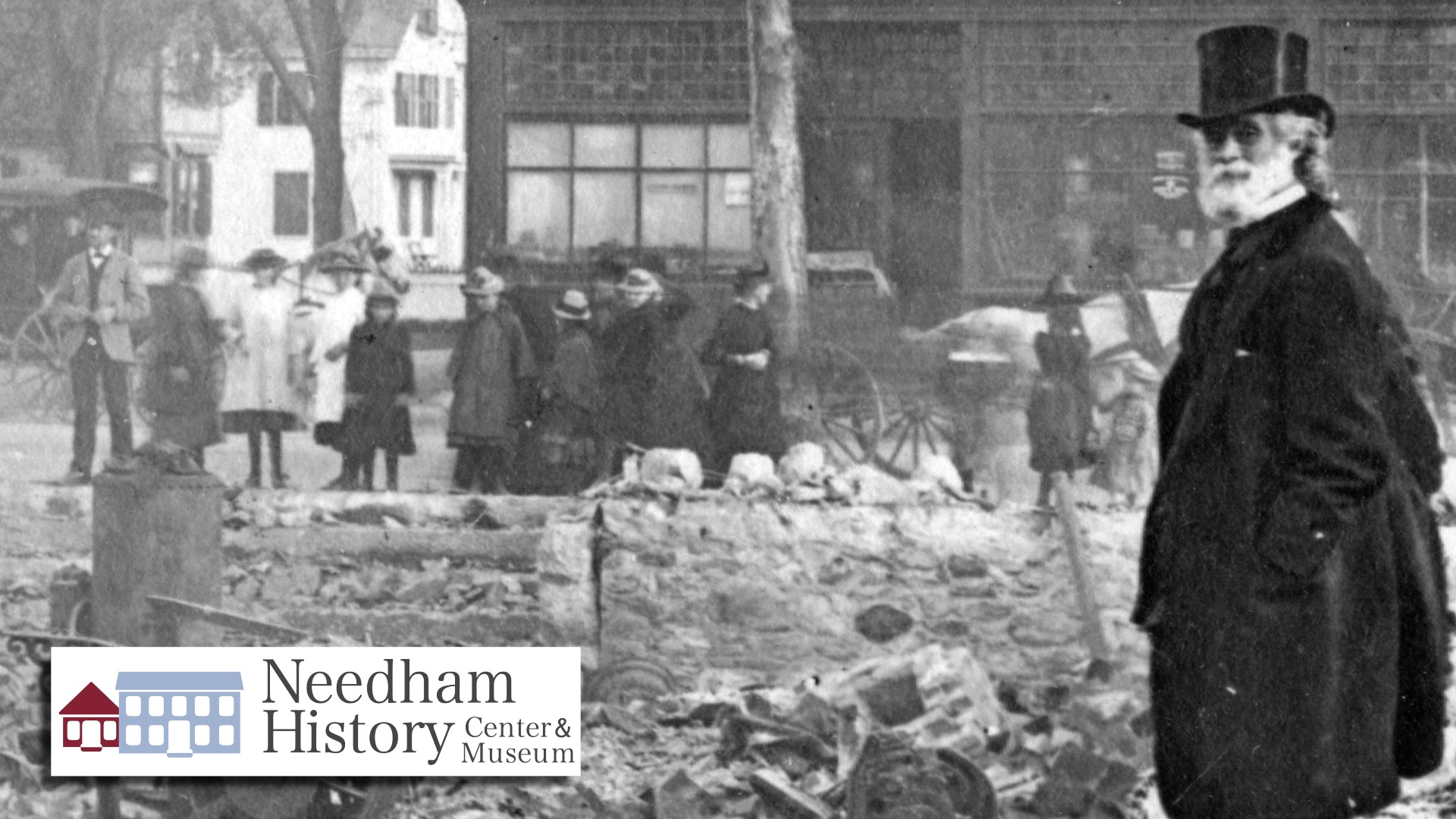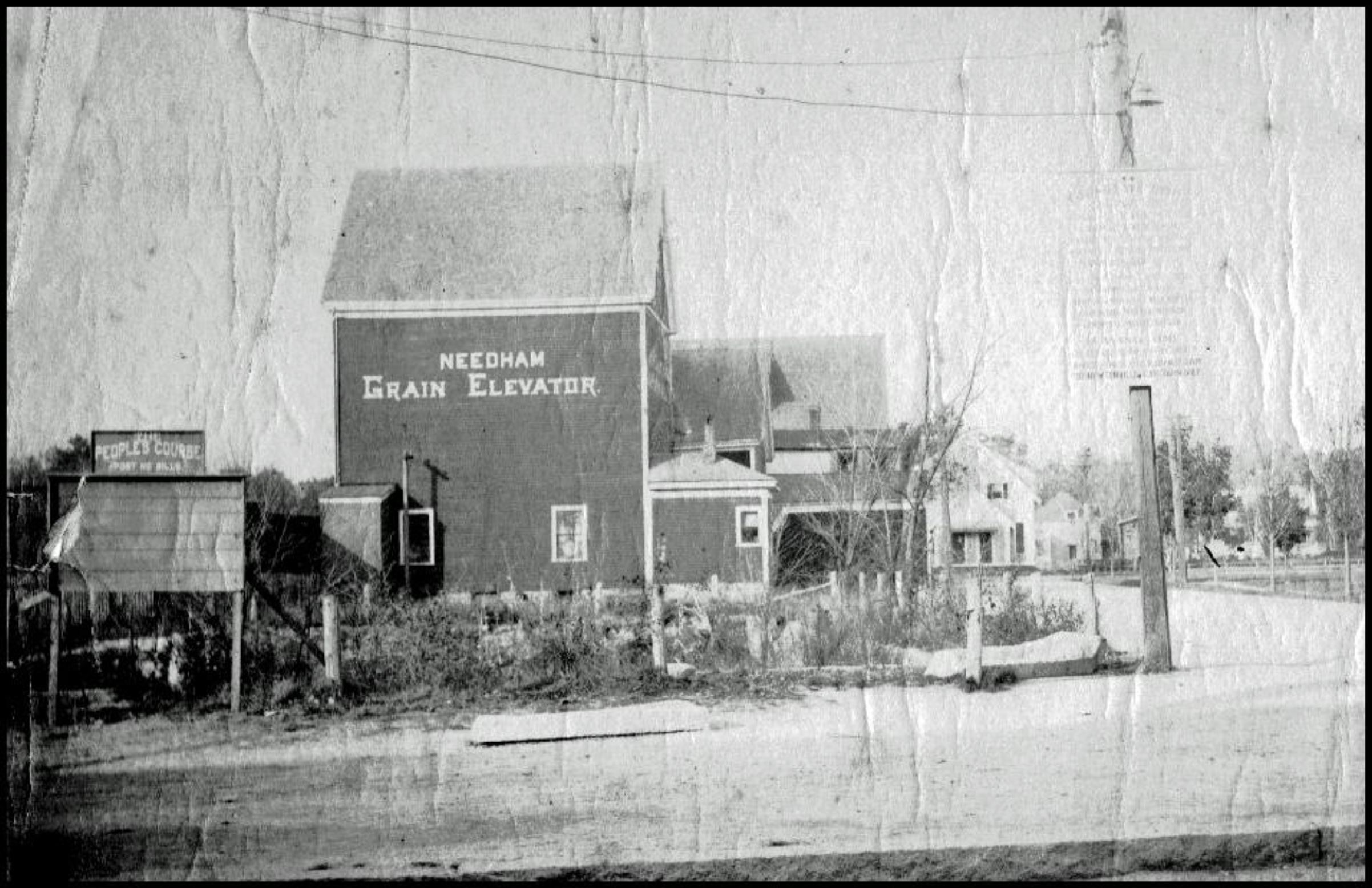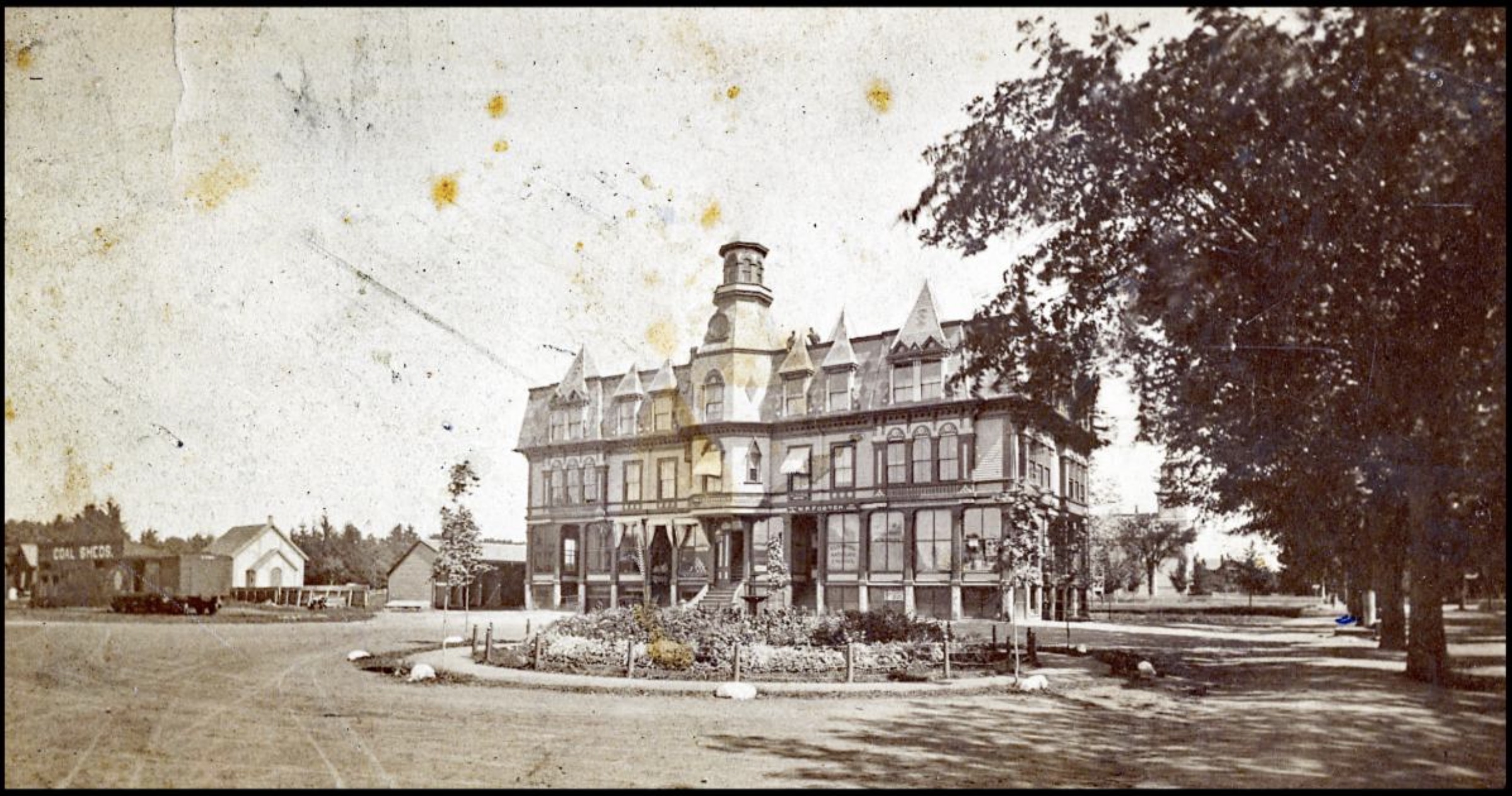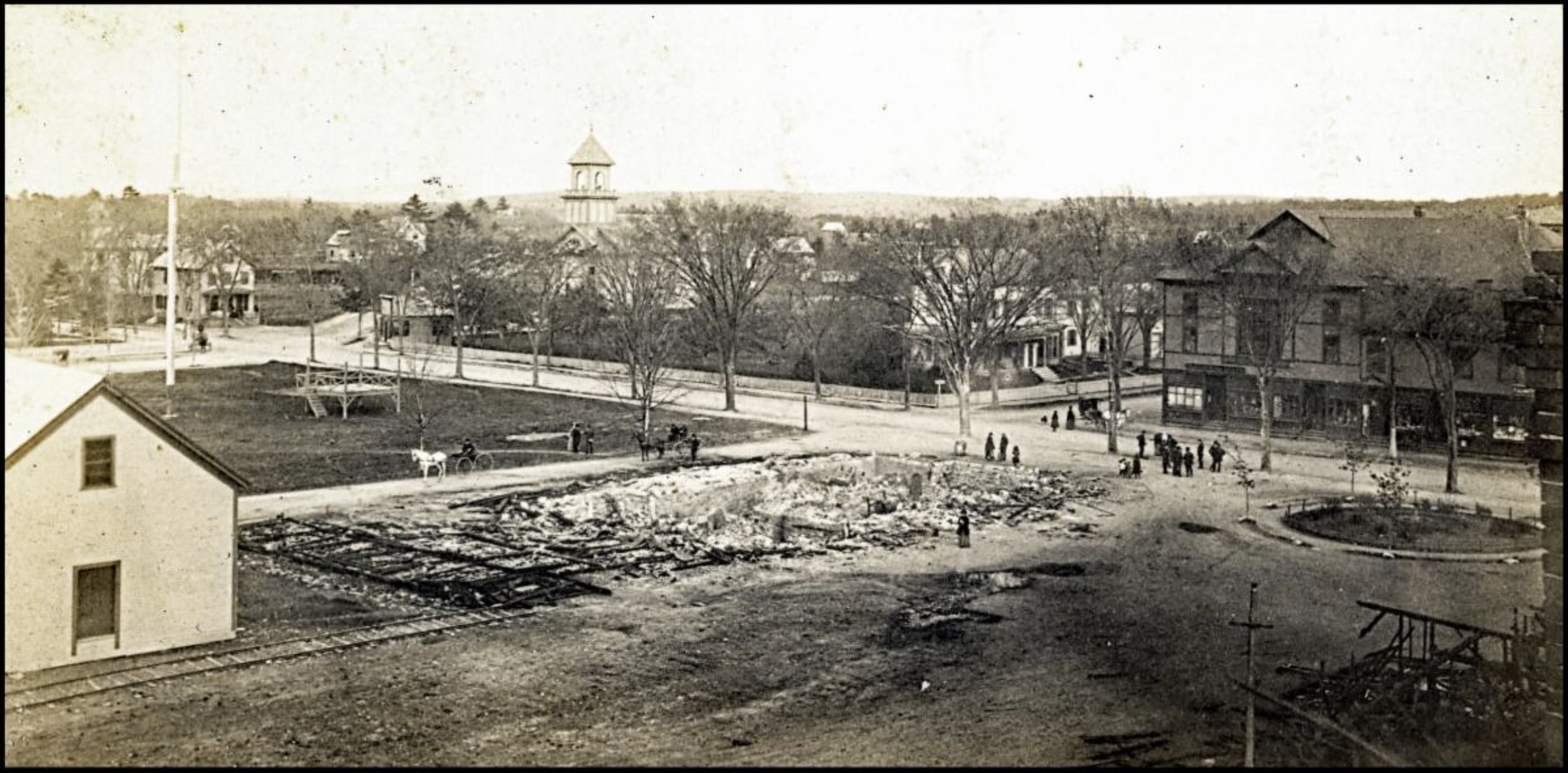
Needham History: The Old Cellar Hole
A vacant, weed-clogged lot – for twenty-nine years!

The corner of Great Plain Avenue and Chapel Street around 1910, with the weedy Cellar Hole in the foreground. The view is toward Chapel Street and the Common. The sign board at left has a header board that reads “The People’s Course. Post no Bills.” The People’s Course was a popular education organization that gave public lectures in the late 19th century; it was also a common moniker for a public golf course.
The Old Cellar Hole
This story always cracks me up. Downtown retail space in Needham is valuable, especially the three prime corner locations at Great Plain Avenue and Chapel/Chestnut Streets. But it was not always thus. In the late 19th century, Needham was perfectly content for one of those corners to remain a weed-clogged empty lot. For thirty years.
Let’s go back a step. In 1880, the new Great Plain downtown was developing and the lots were filling up with both residences and businesses. That year, the Odd Fellows built a very large, very ornate three-story retail block on the northwest corner of Great Plain Avenue and Chapel Street (the old “Crest corner,” now the wine store). The building housed numerous businesses, as well as meeting rooms, and a museum organized by the GAR Civil War veterans that displayed much of Needham’s Revolutionary War and Civil War memorabilia.
The Odd Fellows Block burned down in a spectacular arson-induced fire one night in May 1887, the largest of a rash of arson fires that were set that spring.
“The penetrating whistle of the Boston train arriving at midnight on Friday of last week, gave [the alarm] to the people of Needham that its principal and most ornate business block, Odd Fellows Building, was in flames. … Although the fire had evidently just but started, and people were soon on the spot, the flames increased with such wonderful rapidity that not a scrap could be taken from any part of the building. Its origin was in the basement, and…a dense smoke arose like some black demon of night.” (The Needham Chronicle, May 21, 1887).
Despite its grandeur, it had become clear early on that the building had problems. In 1876, the School Committee called it a “fire trap.” A Citizen wrote to the Needham Chronicle in 1883 to dispute “…the report that has gone about within a week or two, that the Odd Fellows Building is unsafe for a large company to assemble in…” Even the editor of the Chronicle offered only faint praise – “From turret to foundation stone it was a thing of beauty… It cannot be denied that it was inconvenient and never adapted to the purpose for which it was designed.”
The fire on May 13th was fast and destructive, consuming the building in little more than an hour, and leaving almost nothing behind to salvage. Firefighters from the new Station #1 on Chestnut Street arrived quickly, but their hand-pumped trucks and limited water supply were no match. Instead, they turned their efforts to preventing the loss of other properties.
Of the Odd Fellows Block, there was nothing to save, and nothing to rebuild. Since all of the Block’s tenants, as well as the building’s owner, were uninsured or underinsured, none were considered suspects. Besides, there had been several suspicious fires in Needham that spring, so the likelihood that one of the businessman was behind them all was slim. A reward was offered, but the arsonist was never identified. Pictures of the site after the fire show the extent of the devastation. Nothing was left but the cellar hole – not even a fragmentary wall or a chimney stack was left standing.
The Odd Fellows Block as it appeared in 1883, at the corner of Great Plain Avenue and Chapel Street. This view is from Great Plain Avenue, looking east toward the Common. The train yard is in the foreground. The white house (left, back) is the Evangelical Congregational Chapel that used to stand on Chapel Street. The Baptist Church, in its original location at the corner of Great Plain and Highland Avenues, can be seen in the background to the right.

So what to do? Simple – push the scattered debris into the cellar hole and build a fence around it and walk away. And that’s what they did.
And so the site remained for 29 years, an entire generation. Weeds grew up in the lot, giving it an unsightly and derelict appearance. It took on its own identity, and became a Place in its own right – The Old Cellar Hole. It was a landmark – “Turn right at the Cellar Hole.” “Next door to the old Cellar Hole.”
Thirty years seems inexplicable to us – surely someone wanted the site? But one reason it remained so long was that the Great Plain Avenue downtown that we know was just starting to develop at that time. The train line came through the Great Plain in 1853 and started to draw businesses in around it, but that was a process that took decades. If you look at the post-fire picture, you are also seeing the entirety of Needham’s new downtown – the Moseley block on the opposite corner, the First Parish Church (newly moved to that location), the Baptist Church just out of view to the left, the vacant Common. The other buildings were mostly residential, with a few small shops mixed in. The change was just starting to accelerate, and would not really take off until the 1890s.
It wasn’t until 1916 that someone wanted to take on clearing and filling the corner lot for building. That was the year that the now-familiar row of one-story storefronts was
built. The central location was taken by The Crest in the 1920s, and the row has been known as the Crest Block pretty much ever since, even though The Crest closed in
1995. Needham’s memories can be long, and stubborn.
The cellar hole that was all that remained on the morning after the fire on 13 May 1887. Despite the size of the building, it was built mostly of wood. The large building across the street was the Moseley Block (retail); the First Parish Church is left of center; and the Common, with a flagpole and stand, is behind the white horse. The light building at the left edge was part of Crossman’s grain elevator.

 |
Gloria Polizzotti Greis is the Executive Director of the Needham History Center & Museum. For more information, please see their website at www.needhamhistory.org. |

